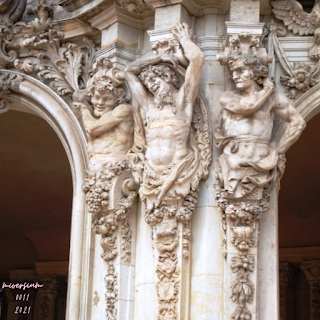THE HERMENS IN DRESDEN ZWINGER
The Dresden Zwinger is a historic building complex located in the heart of Dresden, Germany. One of its most prominent features is the collection of statues known as the "Hermensäulen" or "Hermens" in English. These statues, which are made of sandstone and stand over two meters tall, were created in the 18th century and are still on display in the Zwinger today.
The Hermensäulen were designed by Matthäus Daniel Pöppelmann, the architect responsible for the construction of the Zwinger, and were sculpted by Balthasar Permoser. The statues are based on the ancient Roman tradition of the herm, a sculpted head of the god Hermes mounted on a pillar or column. In the Zwinger, the Hermensäulen depict the heads of various gods and goddesses from Greek and Roman mythology, including Zeus, Hera, Apollo, Athena, and Venus.
One of the most striking features of the Hermensäulen is their intricate details. Each statue is carved with great precision and attention to detail, from the individual strands of hair on the god's head to the folds in their clothing. The statues are also adorned with various symbols and emblems that represent the god's sphere of influence, such as Apollo's lyre or Athena's shield.
The Hermensäulen were not originally intended to be displayed in the Zwinger. Instead, they were created for the Japanese Palace, another building in Dresden that was destroyed during World War II. After the war, the statues were carefully restored and moved to the Zwinger, where they have been on display ever since.
Despite their impressive size and beauty, the Hermensäulen have not been without controversy. In recent years, some have criticized the statues for their depiction of classical gods and goddesses, arguing that they perpetuate an outdated and problematic view of ancient history. Others have defended the statues as important works of art that should be appreciated for their aesthetic and historical value.
Regardless of one's personal views on the Hermensäulen, there is no denying that they are an important part of the Dresden Zwinger's cultural heritage. Visitors to the Zwinger can still marvel at the intricate details and beauty of these statues, which have stood the test of time and continue to be admired by people from all over the world.
MIVERSIUM 0011 the subject of HERMENS

Comments
Post a Comment